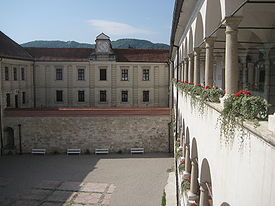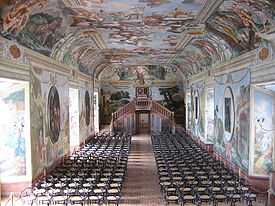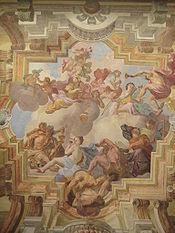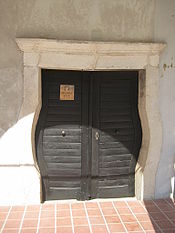
Brežice Castle
Encyclopedia

Brežice
Brežice is a city and municipality in eastern Slovenia in the Lower Sava Valley, near the Croatian border. The area was traditionally divided between Lower Styria and Lower Carniola...
, in southwestern Slovenia
Slovenia
Slovenia , officially the Republic of Slovenia , is a country in Central and Southeastern Europe touching the Alps and bordering the Mediterranean. Slovenia borders Italy to the west, Croatia to the south and east, Hungary to the northeast, and Austria to the north, and also has a small portion of...
., at the street address of Cesta prvih borcev 1.
As with the town, the castle's name derives from the diminutive plural of the Slovene word breg, "riverbank," in reference to the nearby rivers Sava and Krka.
History
A wooden fortification was present on the site long before 1241, when BrežiceBrežice
Brežice is a city and municipality in eastern Slovenia in the Lower Sava Valley, near the Croatian border. The area was traditionally divided between Lower Styria and Lower Carniola...
(then known as Gradišče) is first mentioned. A castrum is first recorded in 1249; the predecessor of the current castle, it was probably built during the late 12th century, when Brežice became the administrative and economic center of the Bishopric of Salzburg
Salzburg
-Population development:In 1935, the population significantly increased when Salzburg absorbed adjacent municipalities. After World War II, numerous refugees found a new home in the city. New residential space was created for American soldiers of the postwar Occupation, and could be used for...
's holdings in Posavje
Posavje
The Lower Sava Valley is a region in southeastern Slovenia on the border with Croatia. It has three major urban centers: Brežice, Krško, and Sevnica. Its borders are almost identical with those of the Lower Sava statistical region....
. In addition to a garrison, the castle hosted a mint
Mint (coin)
A mint is an industrial facility which manufactures coins for currency.The history of mints correlates closely with the history of coins. One difference is that the history of the mint is usually closely tied to the political situation of an era...
and judicial chambers. The castle was then known by the German
Germans
The Germans are a Germanic ethnic group native to Central Europe. The English term Germans has referred to the German-speaking population of the Holy Roman Empire since the Late Middle Ages....
name Rain, as was the surrounding settlement (also meaning "riverbanks").
In 1479, the Brežice area was caught up in a war between the emperor Frederick III
Frederick III, Holy Roman Emperor
Frederick the Peaceful KG was Duke of Austria as Frederick V from 1424, the successor of Albert II as German King as Frederick IV from 1440, and Holy Roman Emperor as Frederick III from 1452...
of Habsburg
Habsburg
The House of Habsburg , also found as Hapsburg, and also known as House of Austria is one of the most important royal houses of Europe and is best known for being an origin of all of the formally elected Holy Roman Emperors between 1438 and 1740, as well as rulers of the Austrian Empire and...
and Hungarian
Hungary
Hungary , officially the Republic of Hungary , is a landlocked country in Central Europe. It is situated in the Carpathian Basin and is bordered by Slovakia to the north, Ukraine and Romania to the east, Serbia and Croatia to the south, Slovenia to the southwest and Austria to the west. The...
king Matthias Corvinus; the latter's forces took the castle from the Salzburgers and occupied it until a peace treaty was signed in 1491, at which point it was transferred to the Habsburgs.
During the great peasant's revolt of 1515, local Carniola
Carniola
Carniola was a historical region that comprised parts of what is now Slovenia. As part of Austria-Hungary, the region was a crown land officially known as the Duchy of Carniola until 1918. In 1849, the region was subdivided into Upper Carniola, Lower Carniola, and Inner Carniola...
n nobility appealed for help to the ban
Ban (title)
Ban was a title used in several states in central and south-eastern Europe between the 7th century and the 20th century.-Etymology:The word ban has entered the English language probably as a borrowing from South Slavic ban, meaning "lord, master; ruler". The Slavic word is probably borrowed from...
of Croatia
Croatia
Croatia , officially the Republic of Croatia , is a unitary democratic parliamentary republic in Europe at the crossroads of the Mitteleuropa, the Balkans, and the Mediterranean. Its capital and largest city is Zagreb. The country is divided into 20 counties and the city of Zagreb. Croatia covers ...
, who dispatched a force under the knight Marko of Klisa. En route, the knight captured some 500 wives and children of the rebellious peasants and sold them into slavery in the Croatian Littoral. A force of 900 peasants subsequently gathered at Brežice, awaiting Sir Marko, who burned down the town before retreating into the castle, which the enraged rebels then stormed, killing him and his retainers before burning it.

Ferdinand I, Holy Roman Emperor
Ferdinand I was Holy Roman Emperor from 1558 and king of Bohemia and Hungary from 1526 until his death. Before his accession, he ruled the Austrian hereditary lands of the Habsburgs in the name of his elder brother, Charles V, Holy Roman Emperor.The key events during his reign were the contest...
approved an outlay of 3000 florins for the construction of a new castle and the fortification of the town. Between 1530 and 1551, Italian master builders demolished the ruins of the old castle and erected the principal elements of the current structure, four defensive towers connected by double defensive walls. The architects included Julio Dispatio of Meran. In 1554/5 the known renaissance builders, the brothers Andrea and Domenico del'Allio, worked on the castle. An armorial stele
Stele
A stele , also stela , is a stone or wooden slab, generally taller than it is wide, erected for funerals or commemorative purposes, most usually decorated with the names and titles of the deceased or living — inscribed, carved in relief , or painted onto the slab...
built into the facade informs that the works were finally completed by the tenure of the noble Franc Gall von Gallenstein
Gall von Gallenstein
The noble family Gall von Gallenstein, sometimes referred to as Gall zu Gallenstein, von Gallenstein, and nowadays sometimes simply Gallenstein was a royal house and is best known for their castle of the same name...
in 1590.
In addition to surviving Turkish raids, the castle was the only fortress in Posavje to withstand another peasants' revolt in 1573, led by Ilija Gregorič. The corners towers were defended by three cannons each, preventing close action.

Frankopan
The Frankopans are a Croatian noble family. Also called Frankapan, Frangepán in Hungarian, and Frangipani in Italian.The Frankopan family is the leading princely Croatian aristocratic family which dates back to the 12th Century and even earlier to Roman times...
. After the death of Julianna of Frankopan in 1694, her heirs sold it to count Ignatz Maria Attems, who furnished the castle with its current interior decorations, including extensive trompe-l'œil frescoes. Images on the walls of the great hall trace the progression of architecture from antiquity through the renaissance, while the ceiling bears scenes from Greek
Greek mythology
Greek mythology is the body of myths and legends belonging to the ancient Greeks, concerning their gods and heroes, the nature of the world, and the origins and significance of their own cult and ritual practices. They were a part of religion in ancient Greece...
and Roman mythology
Roman mythology
Roman mythology is the body of traditional stories pertaining to ancient Rome's legendary origins and religious system, as represented in the literature and visual arts of the Romans...
.
In addition to filling in the moats, a terrace was built up beneath the south wing, making room for orchards and gardens. Around 1720 the west wing was remodeled, and a great staircase and chapel built, the walls of each being decorated by Styrian painter Franc Ignac Flurer between 1715 and 1732. The Attems had the castle re-roofed in the second half of the 18th century; the towers were given Mansard roof
Mansard roof
A mansard or mansard roof is a four-sided gambrel-style hip roof characterized by two slopes on each of its sides with the lower slope at a steeper angle than the upper that is punctured by dormer windows. The roof creates an additional floor of habitable space, such as a garret...
s at the same time.
The castle was significantly damaged by an earthquake that struck the town of Brežice on January 29, 1917, during World War I
World War I
World War I , which was predominantly called the World War or the Great War from its occurrence until 1939, and the First World War or World War I thereafter, was a major war centred in Europe that began on 28 July 1914 and lasted until 11 November 1918...
, at which time the great hall served as a military hospital
Military hospital
Military hospital is a hospital, which is generally located on a military base and is reserved for the use of military personnel, their dependents or other authorized users....
. The counts Attems retained the estate until its nationalization
Nationalization
Nationalisation, also spelled nationalization, is the process of taking an industry or assets into government ownership by a national government or state. Nationalization usually refers to private assets, but may also mean assets owned by lower levels of government, such as municipalities, being...
in 1945, for a total tenure of 251 years.
Current
Immediately after the war, the castle was divided into apartments for 26 families. In 1949, the castle became the home of the Posavski Museum. The museum's holdings began with its first director, Franjo Stiplovšek, who brought them from KrškoKrško
Krško is a town and municipality in eastern Slovenia. The town lies on the Sava River. The area is traditionally divided between Lower Styria and Lower Carniola...
(the Aumann collection); they were later expanded and divided into archeological, ethnological, and historical exhibitions (the latter focusing on the peasant's revolt). There is also a gallery, focusing on foreign and domestic oil painting.
The castle is a frequent venue for cultural events, including concerts of the Brežice Festival. The great hall is also a popular location for marriages. The castle's basement has since 1946 been occupied by a wine cellar, Grajska Klet ("Castle Cellar").
It is located at the south end of the town's main street. Hours are 8-14:30 weekdays, 10-14:00 Sundays and holidays.
Architecture

The structure has two stories, as well as a basement carved out of bedrock. The castle once also possessed a moat and drawbridge, but though the latter's chains remain, both were removed after the course of the river Sava (which had filled the moat) moved away over the centuries.
The characteristic bowed gateway is the symbol of the castle's wine cellar.
Sources
- Posavski Museum website (In Slovene)
- castle floor plan - Posavski Museum website (In Slovene)
- visitbrezice.com aerial photos of the castle (In Croatian)

